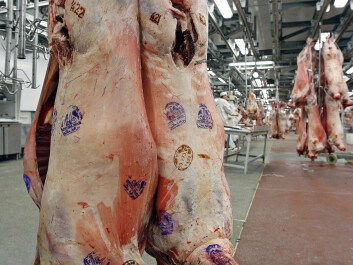Do Stress Hormones In Animals Affect Humans
Denne artikkelen er over ti år gammel og kan inneholde utdatert informasjon.
You've got your home polished and decorated but you still need to dash around to make the last preparations for a festive dinner.
But people are non the only creatures who experience stress. The animals that are destined to be meat on our dinner tables could have had a very tense trip to the slaughter-house.
Research shows that stress amongst livestock affects the quality of meat as regards tenderness, perishability and colour.
More than important is what they eat

Eli Gjerlaug-Enger is an animal husbandry researcher at the cooperative for Norwegian pork producers, Norsvin, and says 1 of the aims of her trade is the elimination of tension.
"The animals that yield prime meat quality are the ones that have non been subjected to stress," she says.
However, Gjerlaug-Enger doesn't call up stress affects the healthiness of meat.
"Stress alters protein limerick, vitamin content and minerals. Simply in all the research fabric I've come beyond, I've seen no connectedness between stress levels and less healthy meat," she says.

As regards to healthiness of the meat information technology's more important to focus on what the animal eats.
Sections of Norwegian regulations are aimed at mitigating livestock stress.
"Forth with Sweden and Switzerland nosotros have the world'due south nearly stringent regulations for raising pigs," says Gjelaug-Enger.
She adds that pigs are given things to play with in their pens because they become stressed by inactivity.
8 hour drive to the slaughterhouse
Lots of factors tin can have stressed your ham when information technology was nonetheless upward and oinking. Researchers nosotros've contacted mention several:
Inactivity, noises, new boars in the pen and long transport distances to the slaughterhouse can exist stressful for the animals.
Norwegian regulations limit the elapsing of this transportation to a maximum of eight hours. Withal in special circumstances this can be extended to 11 hours.
Everyone interviewed for this article agrees that nobody gains from stressed animals, because information technology's detrimental to fauna welfare and meat quality.
Merely they disagree as to whether enough is washed to provide livestock with an laid-back daily life.
Cheaper food is not favourable for the animals
Ann-Margaret Grøndahl is a researcher at the Norwegian Veterinary Establish.
She isn't convinced that the law sufficiently protects livestock against stress.
She says the regulations about providing activities for the animals may wait corking on paper just the salient point is what is actually done, and that can vary widely.
A project conducted by the Norwegian Veterinary Institute investigates how altitude from the farm to the slaughterhouse affects animal welfare and meat quality.
The geographical construction of slaughterhouses has changed in Norway in past decades. Several smaller, local slaughterhouses have closed down and just a few, larger ones have survived.
"This ways that many animals are subjected to long hauls, and in many rural areas these rides are on narrow, curvy, bumpy roads, which are stressful for the livestock," Grøndahl explains.
"Consumers demand increasingly cheaper nutrient, so efforts are made to cutting costs in every pace of livestock product. Unfortunately this is unfavourable for the animals," concludes Grøndahl.
Lack of enquiry on stress
Picayune research has been conducted to date regarding how livestock stress influences the health-giving qualities of meat.
Many presume that this lack of research relates to the fact that there are no indications that the meat is unhealthy for us to consume.
"Every bit long every bit the stress factors are limited to transport and butchering, there are no reasons to think this affects nutrition," says Laila Aass.
Aass is a researcher at the Department of Animal and Aquaculture Sciences at the Norwegian University of Life Sciences at Ås (UMB).
Her work is mainly with the link between genetics and beef production quality but she likewise investigates environmental factors such every bit stress.
"If an animal is mistreated, causing for instance infections, information technology's reasonable that this tin affect nutritional content," she says.
She emphasizes that animals with infections are culled by the nutrient manufacturing controllers at the slaughterhouse and these are destroyed and never used for food.
Night, firm and dry meat
Laila Aass explains that stressed cattle yield DFD-meat, an abridgement for Dark, Firm and Dry.
"It affects perishability," says Aass.
DFD is acquired by the muscles of the animals being depleted of their stored muscle energy prior to slaughtering, which hinders a natural decrease in pH level after the animal dies.
Aass says it's like shooting fish in a barrel to encounter this in meat, and information technology is sorted out at the slaughterhouse.
This doesn't necessarily hateful it isn't used.
Aass explains that DFD-meat cannot be utilised for beefiness destined for ageing, but it can be used for products that are salted, smoked or heat-treated, such every bit smoked sausages.
Genetic flaw eliminated
Stressed pigs yield the reverse effect every bit cattle. Pork becomes PSE-meat (Pale, Soft and Exudative).
According to researchers at Norsvin, PSE-meat stems from a genetic flaw that makes the pigs unable to tackle the stress of being transported to the slaughterhouse.
Researchers say this can be eliminated through selective breeding and the problem is no longer found among Norwegian pigs.
Only stressed cattle can more readily develop DFD-meat, because they have less stored energy, or glycogen, in their muscle tissue.
Just even pigs tin can develop DFD, if they are starved and subjected to long-term stress, according to Eli Gjerlaug-Enger at Norsvin.
Little long-term stress
The lives of livestock are often so short that long-term stress lacks time to develop, only a few pigs live quite a long time before they are butchered.
According to the statistics on the website animalia.no about 1.5 one thousand thousand pigs are slaughtered in Norway annually.
And 95 percent of the pork that ends upwards on Norwegian tables comes from pigs that have been slaughtered at the historic period of 5 months.
Sows represent four per centum, which means that effectually lxx,000 of them are butchered in Kingdom of norway every year.
There are no statistics regarding how old sows are when they are slaughtered only on the average they have three farrows. That puts them at the age of ane.5 to 3 years.
In a few cases they are slaughtered even later in life.
Sows become sausage
Tor Olav Brandtzæg is an information officeholder at Nortura, a merger between two large Norwegian meat and poultry producers Gilde and Prior.
He says that pork from sows is often used in processed meat products and sausages.
"This depends on the size and coarseness of the meat. The best filets come from pigs that are younger than sows."
Just Brandtzæg doesn't call back the length of life has whatever bear on on the healthiness of the meat.
"The influence of stress on meat is well-nigh oft caused past sudden incidents, such as transport or arriving at a slaughter-house.
The stressing of animals harms their welfare and the quality of their meat, so nosotros have routines that brand for as little stress equally possible," he says.
Brandtzæg says that very few transports are as long every bit the eight hour limit, but even short trips can be unfavourable.
"For example pigs get stressed by loading and unloading, so short trips tin can mean more anxiety for them because they don't get plenty time to settle downward on the vehicle," says Brandtzæg.
----------------------------------------
Read the article in Norwegian at forskning.no
Translated by: Glenn Ostling
Related content
Source: https://sciencenorway.no/agriculture--fisheries-animal-welfare-food-safety/is-meat-from-stressed-animals-unhealthy/1426527
Posted by: hernandezflery1974.blogspot.com

0 Response to "Do Stress Hormones In Animals Affect Humans"
Post a Comment